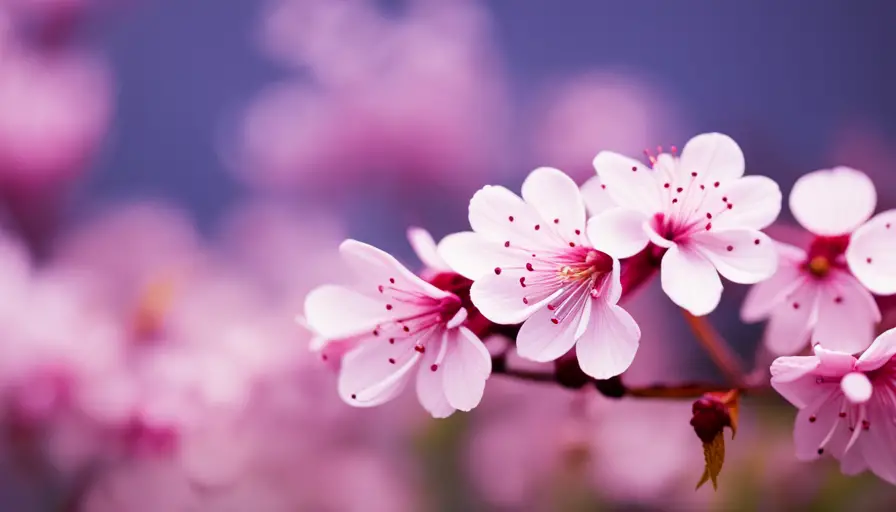Cherry blossoms have long captivated people around the world with their delicate beauty and ephemeral nature.
These stunning flowers, also known as sakura in Japan, hold deep cultural significance and symbolize a range of meanings. From renewal and rebirth to the transient nature of life itself, cherry blossoms are rich with symbolism that resonates across cultures.
One of the most prominent meanings associated with cherry blossoms is their representation of new beginnings and fresh starts.
In Japanese culture, these blooms mark the arrival of spring and serve as a reminder of how life constantly renews itself. The sight of cherry trees bursting into full bloom is often seen as a hopeful sign after the cold winter months, inspiring feelings of optimism and growth.
The History of Cherry Blossoms
Cherry blossoms have a rich history that spans centuries. These beautiful flowers hold deep cultural significance and are cherished by many around the world.
- Originating in Japan: Cherry blossoms, known as “sakura” in Japanese, are closely associated with Japanese culture. They have been cultivated in Japan for over a thousand years and have become an iconic symbol of the country.
- Symbolism in Japanese Culture: In Japan, cherry blossoms symbolize the ephemeral nature of life and serve as a reminder to appreciate its beauty and transience. They also represent renewal, hope, and new beginnings.
- Hanami Tradition: The tradition of hanami, which means “flower viewing,” involves gathering under cherry blossom trees to admire their beauty during their blooming period. This tradition dates back to ancient times and is still widely celebrated today through festivals and picnics.
- Influence on Art and Literature: Cherry blossoms have inspired countless artists, poets, and writers throughout history. Their delicate petals and vibrant colors often feature prominently in traditional paintings, haiku poetry, and other forms of artistic expression.
- Spread across the Globe: Over time, cherry blossoms have spread beyond Japan’s borders and gained popularity worldwide. Many countries now celebrate cherry blossom festivals to honor these exquisite flowers.
- Significance in Different Cultures: While most commonly associated with Japan, cherry blossoms also hold symbolic meaning in other cultures. In China, they represent feminine beauty and power. In Korea, they embody purity and innocence.
- Global Connections: The gift of cherry blossom trees from Japan has fostered diplomatic relationships between nations as a gesture of goodwill and friendship. Notable examples include the gift of sakura trees to Washington D.C., which led to the annual National Cherry Blossom Festival.
- Environmental Impact: Cherry blossoms play a vital role in the ecosystem, attracting pollinators such as bees and butterflies. They also contribute to biodiversity and serve as a natural indicator of seasonal changes.
Cherry Blossom Symbolism in Japanese Culture
When it comes to symbolism, few things hold as much significance in Japanese culture as the cherry blossom. These delicate and ephemeral flowers have captivated the hearts of the Japanese people for centuries, becoming a powerful symbol that represents various aspects of life and society. In this section, we’ll explore the profound meaning behind cherry blossoms in Japanese culture.
Beauty and Transience
The most prominent symbolism associated with cherry blossoms is their beauty and transience. The short-lived nature of these blossoms serves as a reminder of the fleetingness of life itself. It’s a poignant metaphor for the impermanence of our existence and encourages us to appreciate each moment to its fullest.
New Beginnings and Renewal
In Japan, cherry blossoms mark the arrival of spring, a season associated with new beginnings and renewal. As winter fades away, these blossoms burst forth with vibrant colors, signaling the start of a fresh chapter. They inspire hope and optimism for what lies ahead while reminding us that every ending is also an opportunity for growth.
Samurai Spirit
Cherry blossoms have deep roots in samurai culture as well. For warriors who lived by the code of bushido, or “the way of the warrior,” cherry blossoms represented bravery, loyalty, and honor. Like these flowers that bloom fearlessly despite their fragility, samurais embraced both strength and vulnerability in their pursuit of justice.
Enjoying Life’s Simple Pleasures
Hanami, or flower viewing parties held during cherry blossom season, are beloved traditions in Japan. Families and friends gather beneath blooming trees to appreciate their beauty while enjoying food, drinks, and each other’s company. This practice emphasizes the importance of savoring life’s simple pleasures together—a lesson we can all learn from.
Cherry Blossoms as a Sign of Spring
When the winter frost begins to thaw and the days start to grow longer, nature signals the arrival of spring in a spectacular way – through the blooming of cherry blossoms. These delicate flowers, with their soft pink and white petals, have become an iconic symbol of this season of renewal.
Here are a few reasons why cherry blossoms are regarded as a sign of spring:
- Nature’s Awakening: As winter fades away and temperatures rise, cherry trees burst into bloom, adorning landscapes with their vibrant colors. This visual spectacle serves as a powerful reminder that nature is awakening from its slumber and new life is about to emerge.
- Renewal and Rebirth: The blooming of cherry blossoms symbolizes renewal and rebirth. After months of cold weather and bare branches, witnessing these exquisite flowers in full bloom is a testament to the cycle of life starting anew.
- Fleeting Beauty: One unique aspect that adds to the allure of cherry blossoms is their ephemeral nature. The flowers only last for a brief period before they fall gracefully to the ground, reminding us that beauty can be transient but still worth cherishing.
- Cultural Significance: Cherry blossoms hold deep cultural significance in many countries around the world, particularly in Japan where they are revered as a national symbol. The annual tradition of hanami (flower viewing) brings people together to appreciate the beauty of these blooms while celebrating the arrival of spring.
- Hope and Optimism: After enduring months of cold weather, seeing cherry blossoms in bloom instills feelings of hope and optimism for brighter days ahead. Their delicate petals serve as a gentle reminder that even after adversity, there is always room for growth and beauty in life.
The sight of cherry blossoms blooming against blue skies paints an enchanting picture that captivates both locals and visitors alike. Their significance as a sign of spring goes beyond their aesthetic appeal, representing the resilience and beauty that can emerge from even the harshest of winters.
So, when you spot those first delicate blossoms on the branches, take a moment to appreciate the arrival of spring and all the promise it holds.
Cherry Blossoms in Art and Literature
Cherry blossoms have long captivated artists and writers, inspiring them to create beautiful works that celebrate the ephemeral beauty and symbolic meaning of these delicate flowers. From ancient paintings to modern literature, cherry blossoms hold a special place in the hearts of many.
1. Traditional Japanese Art:
In Japan, cherry blossoms, known as “sakura,” have been depicted in art for centuries. The delicate pink petals symbolize the transient nature of life and are often associated with concepts such as beauty, renewal, and impermanence. Artists use various techniques like ink wash painting (sumi-e) or woodblock prints (ukiyo-e) to capture the ethereal essence of cherry blossoms.
2. Haiku Poetry:
Haiku, a traditional form of Japanese poetry, frequently references cherry blossoms. These short poems aim to convey deep emotions using few words. Haiku poets often use cherry blossoms as a metaphor for fleeting moments or the passage of time. The juxtaposition between the transient nature of cherry blossoms and human existence creates a sense of contemplation within these elegant verses.
3. Symbolism in Western Literature:
Cherry blossoms have also found their way into Western literature as symbols of beauty, fragility, and love. Writers incorporate cherry blossom imagery to evoke feelings of nostalgia or depict scenes filled with tranquility and serenity. Whether it’s an evocative description in a novel or a vivid image painted through poetic language in verse, cherry blossoms add depth and meaning to literary works across different genres.
4. Influence on Visual Arts Worldwide:
The influence of cherry blossoms extends beyond Japan’s borders; they are celebrated worldwide through various forms of visual arts. Painters around the globe have been inspired by these enchanting flowers, incorporating them into their own unique styles and interpretations.
5.Cultural Significance:
Cherry blossoms are not only admired for their aesthetic beauty but also hold cultural significance. They are a symbol of hope, renewal, and the transient nature of life in many cultures. The annual cherry blossom festivals that take place in different countries attract millions of visitors who come together to appreciate this natural spectacle.
Cherry Blossom Festivals Around the World
One of the most captivating aspects of cherry blossoms is how they have inspired festivals around the world. These celebrations bring people together to admire the beauty and symbolism of these delicate flowers. Let’s take a closer look at some of the most notable cherry blossom festivals:
- Sakura Matsuri in Japan: The land where cherry blossoms hold deep cultural significance, Japan hosts numerous cherry blossom festivals throughout its cities. The Sakura Matsuri festival in Tokyo is one of the largest and most famous, attracting millions of visitors each year. It features traditional music, dance performances, and food stalls offering delicious Japanese cuisine.
- National Cherry Blossom Festival in Washington, D.C., USA: Every spring, Washington, D.C., bursts into vibrant colors as thousands of cherry trees bloom along the Tidal Basin. This event commemorates the gift of 3,000 cherry trees from Japan to the United States in 1912. The festival includes a grand parade, art exhibitions, live performances, and fireworks.
- Jinhae Gunhangje Festival in South Korea: Held in Jinhae-si near Busan, this festival celebrates not only cherry blossoms but also Korean naval history. Visitors can enjoy breathtaking views of pink blossoms while exploring historical sites like Gyeonghwa Station and attending cultural events such as traditional music concerts.
- Hanami Festival in Kyoto, Japan: Known for its stunning temples and gardens, Kyoto offers a unique experience during hanami season when locals gather under blooming cherry trees to enjoy food and drinks with friends and family. The Philosopher’s Path along the canal is a popular spot for hanami parties.
- Vancouver Cherry Blossom Festival in Canada: As an international city known for its diversity and natural beauty, Vancouver showcases over 40 varieties of cherry trees during its annual festival. Events include tree plantings across neighborhoods, guided walks, and art installations inspired by cherry blossoms.
Cherry blossom festivals serve as a reminder of the fleeting nature of life and the beauty that can be found in embracing impermanence. Each festival has its own distinct charm, but they all share a common appreciation for the enchanting allure of cherry blossoms.
Cherry Blossoms as a Symbol of Renewal and Transience
Cherry blossoms, with their delicate beauty and ephemeral nature, hold deep symbolism in various cultures around the world. In this section, we’ll explore how these enchanting flowers represent renewal and transience.
Renewal:
One of the key symbolic meanings associated with cherry blossoms is renewal. The blooming of cherry blossoms signifies the arrival of spring, a season often associated with new beginnings and fresh starts. As winter fades away, the vibrant pink or white petals unfurl on the branches, signaling a time of growth and rejuvenation.
Transience:
The transient nature of cherry blossoms is another aspect that makes them highly symbolic. The flowers bloom for only a short period, typically lasting just a few weeks before they start to fall gracefully from the trees. This fleeting beauty reminds us of the impermanence of life and encourages us to appreciate each moment.
Appreciating Imperfection:
Another interpretation of cherry blossoms’ symbolism lies in their imperfect beauty. Despite their elegance, individual petals may bear tiny flaws or uneven shapes. However, rather than detracting from their allure, these imperfections add depth and character to each blossom. This teaches us to embrace our own imperfections and find beauty within them.
Cultural Significance:
In Japanese culture, where cherry blossoms are known as “sakura,” they hold great cultural significance. The annual tradition of Hanami (flower viewing) attracts millions who gather under blooming cherry trees to celebrate nature’s transient beauty while enjoying picnics with family and friends.
Cherry Blossom Symbolism in Different Cultures
Cherry blossoms hold a special place in the hearts and minds of people around the world. These delicate flowers have become symbols of beauty, renewal, and transient nature. Let’s explore how cherry blossom symbolism varies across different cultures.
Japan: A Celebration of Transience
In Japan, cherry blossoms are called “sakura” and hold immense cultural significance. The fleeting nature of cherry blossoms is deeply ingrained in Japanese philosophy and aesthetics. They symbolize the beauty and fragility of life, reminding us to cherish each moment.
The arrival of cherry blossoms marks the start of hanami, a centuries-old tradition where people gather under blooming trees to appreciate their ethereal beauty. Hanami parties often involve picnics, music, and poetry readings. It’s a time for reflection on the impermanence of life and the importance of living fully in the present.
China: Love and Femininity
In Chinese culture, cherry blossoms represent love, femininity, and power. They are associated with feminine beauty and elegance. The delicate pink flowers symbolize gracefulness and charm.
Cherry blossoms also have historical significance in China as they were often depicted in ancient artwork as symbols of female dominance or authority. Today, these flowers are commonly seen as decorations during weddings to bring good luck to newlyweds.
Korea: Hope and Renewal
In Korea, cherry blossoms symbolize hope, new beginnings, and prosperity. The ephemeral nature of these blooms is linked to Korean folklore that emphasizes renewal after difficult times.
During springtime festivals known as “Jinhae Gunhangje,” thousands flock to Jinhae city to enjoy breathtaking cherry blossom displays along streets lined with blooming trees. This celebration signifies hope for South Koreans after challenging periods such as wars or political turmoil.
United States: Beauty in Diversity
In the United States, cherry blossoms signify beauty, diversity, and friendship. Over a century ago, Japan gifted thousands of cherry trees to Washington D.C., symbolizing the enduring friendship between the two nations.
The annual National Cherry Blossom Festival in Washington D.C. attracts millions of visitors who come to admire the stunning pink and white blooms. The festival showcases cultural performances, arts and crafts exhibitions, and serves as a reminder of the importance of cross-cultural connections.
Conclusion
Cherry blossoms hold a timeless appeal that captivates people across the globe. As we’ve explored in this article, these delicate flowers symbolize various meanings and evoke a sense of beauty, transience, and renewal. In this concluding section, let’s reflect on why cherry blossoms continue to enchant us year after year.
- A Spectacular Display: The blooming of cherry blossoms is nothing short of a visual spectacle. The vibrant hues of pink and white create a breathtaking canopy that blankets parks, streets, and landscapes. This stunning display attracts millions of visitors who gather to witness nature’s masterpiece unfold before their eyes.
- Cultural Significance: Cherry blossoms have deep cultural significance in countries like Japan, where they are revered as a national symbol. The annual tradition of hanami (flower viewing) brings communities together to celebrate the fleeting beauty of these blooms amidst joyful festivities. This rich cultural heritage adds an aura of mystique to the allure of cherry blossoms.
- Symbolism and Meaning: Beyond their aesthetic appeal, cherry blossoms carry profound symbolism. They remind us of the ephemeral nature of life and the importance of cherishing every moment. Their brief but intense bloom serves as a reminder to seize opportunities and appreciate beauty in its transient form.
- Inspiring Artistic Expressions: Cherry blossoms have inspired countless artists, poets, writers, and photographers throughout history. Their delicate petals find their way into paintings, literature, haikus, and photographs as artists strive to capture their ethereal essence. This artistic expression further enhances their enduring appeal.
- Tourism Draw: Cherry blossom season has become a major draw for tourism in many regions around the world. From Washington D.C.’s National Cherry Blossom Festival to Kyoto’s sakura season in Japan, these events attract travelers from far and wide who wish to immerse themselves in the magical atmosphere created by these blossoms.
In conclusion, the timeless appeal of cherry blossoms lies in their ability to evoke a sense of wonder and capture the essence of fleeting beauty. Their vibrant display, cultural significance, symbolic meaning, artistic inspiration, and tourism draw make them an enchanting natural phenomenon that continues to fascinate people across generations. So next time you witness a cherry blossom bloom, take a moment to appreciate its beauty and contemplate the deeper messages it carries.






Leave a Reply